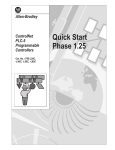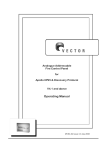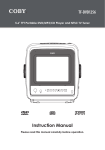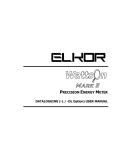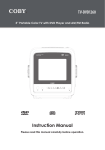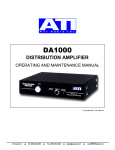Download Wattson Classic Electronics FY-2 Fuzz Owner`s manual
Transcript
Wattson Classic Electronics FY-2 Fuzz Owner's Manual Copyright ©2010 Wattson Classic Electronics All Rights Reserved www.wattson-fx.com Thank You! We'd like to thank you for purchasing the FY-2 Fuzz, from Wattson Classic Electronics. We've designed the FY-2 Fuzz to provide the exact same tone and visual appeal as the classic FY-2 effect from Shin-ei. We've also made some improvements over that classic design, including a rugged 16 gauge steel chassis, an external DC power jack, an LED which lights when the effect is engaged, and a convenient battery drawer that allows you to swap batteries without opening the case. Please read through this brief manual to ensure that you get the most from your FY-2 Fuzz pedal. Installing a battery Your FY-2 Fuzz can be operated from either an external 9VDC power supply, or a conventional 9V battery. For battery operation we recommend you use only alkaline batteries. To remove the battery drawer - place your fingernail or a small coin in the slot at the bottom of the drawer, and lift upward until the drawer "clicks". If there is already a battery in the drawer then the drawer should pop out slightly on it's own. Otherwise, pull lightly on the drawer with your fingernail until it begins to slide out of the case. Grasp the drawer and remove it completely from the case. The battery is held in the drawer by pressure from a spring. You can remove the battery from the drawer by lifting outward at the end with the connector snaps. Insert a fresh battery in the drawer. Be sure to observe the proper polarity or the battery will not fit in the drawer correctly. Insert the drawer into the case, battery side facing up and connector snaps toward the case. Push the drawer into the case until it "clicks". 2 Power interlock Your FY-2 Fuzz pedal features a two stage power interlock which is designed to preserve the battery, and also to permit the use of an external power adapter. In the first stage, the battery ground circuit is interrupted unless there is a plug in the "In" jack on the left side of the pedal. If there is no plug in the "In" jack, then you will not be able to power up the pedal using a battery. The only type of plug which will work with this circuit is a conventional 1/4 inch mono, or "tip-sleeve" (TS) plug, which is standard on most instrument cords. The interlock circuit will NOT work with a stereo, or "tipring-sleeve" (TRS) plug. NOTE: The original Shin-ei FY-2 had the battery interlock circuit on the "Out" jack, rather than the "In" jack. We used the "In" jack because this is the convention with most modern effect pedals. If you have an original Shin-ei pedal then you should note this difference. Removing the plug from the "Out" jack will not disconnect the battery in the Wattson FY-2 Fuzz pedal. In the second stage, the +9VDC circuit from the battery is interrupted whenever there is a plug in the "9VDC" external power supply jack on the right side of the pedal. This allows you to operate the pedal on an external adapter without also drawing current from the battery. You cannot operate the pedal from the battery if there is a plug in the "9VDC" external power supply jack. When operating from a battery the FY-2 Fuzz will draw a small amount of current anytime the interlock circuits are closed, even if the pedal is in "bypass" mode and the effect is not switched on. It will draw even more current when the effect is on and the LED is lit up. The fuzz circuit is not powered down when the effect is switched off in order to avoid any power up delays when you switch on the effect. To make this a little more clear... If you have installed a battery, and have inserted an instrument cord plug into the "Input" jack, and have NOT inserted an external power supply plug into the "9VDC" jack, then the pedal will draw some current from the battery. If you want to preserve your battery power then you should open the interlock connection when the pedal is not in use, either by disconnecting the plug from the "Input" jack, or by inserting a plug into the "9VDC" external power supply jack. Either method will disconnect the battery from the fuzz circuit, and help to conserve battery power. 3 Using an external power supply You can operate your FY-2 Fuzz on an external power supply that meets the following specifications: • 9 volts DC, at least 50 milliamps (mA) • 5mm x 2.1mm connector, tip "negative" For best performance, we strongly recommend you use a well regulated and filtered power supply. Any ripple or noise in the power will be amplified by the FY-2 Fuzz, and come through your amplifier. Cheap power supplies from your local electronics hobby store may not be regulated nor well filtered. Observe the following precautions, or you may permanently damage your FY-2 Fuzz pedal: • Do NOT use a power supply which is rated at more than 9 volts DC. • Do NOT use a power supply which provides AC rather than DC current. • Do NOT use a power supply with the tip connected to "positive". You can operate your FY-2 Fuzz on an external power supply while you have a battery installed. No power will be drawn from the battery when there is a plug in the external power supply jack. A note about "daisy-chained" power supplies A "daisy-chained" power supply can be an enormously useful addition to your pedal board, but they can also cause problems with analog pedals like the FY2 Fuzz. If you have some pedals connected to the input on your amp, and other pedals connected to the effects loop on your amp, then you should not operate these pedals from the same power supply. The effects loop is often not on the same ground level as the input, and using the same power supply for input and effects loop pedals can cause a ground loop, which will result in hum and noise in your analog pedals. You should use one power supply for your input pedals, and a different power supply for your effects loop pedals. Because the FY-2 Fuzz is a fully analog pedal, it is highly susceptible to any noise on the power supply line. Some digital effects may generate high frequency noise on the power supply line, and the FY-2 Fuzz may pick up this noise and amplify it. If you encounter this problem then you should operate the FY-2 Fuzz on a separate power supply from the digital effects pedals which are causing the problem. 4 Connecting the Fuzz to your rig The FY-2 Fuzz has two 1/4 inch jacks on the left side, labeled "In" and "Out". The "In" jack should be connected to the signal chain that ends at your guitar, while the "Out" jack should be connected to the signal chain that ends at your amp. If you have no other effects pedals in your chain, then plug your guitar into the "In" jack, and your amp into the "Out" jack. The FY-2 Fuzz was designed to operate with the signal levels coming from a guitar. It may not perform well when connected to the effects loop on your amplifier. There is much debate about the proper order to connect effects pedals, but the conventional wisdom is generally: • Gain type pedals first. This includes boosters, distortion, fuzz (like the FY-2 Fuzz), overdrive, etc. To keep noise to a minimum, you should connect the lowest noise pedals first, followed by the noisier pedals. • Time based pedals last. This include chorus, echo, delay, reverb, etc. The above recommendations are not engraved in stone. Feel free to experiment with your pedal arrangement to get the tone you want. Using the controls The FY-2 Fuzz has three user-accessible controls (and a fourth "hidden" control we'll talk about in a moment...). These are: • Footswitch - This control is used to turn the fuzz effect on or off. The LED will be lit when the fuzz effect is turned on. • VOL - This knob controls the output level of the pedal when the effect is turned on. You can adjust this knob to balance the "effect on" volume level with the "effect off" volume level. • FUZZ - This knob blends a mixture of the signals from the first and second fuzz stages, changing both the amount of distortion, as well as the timbre of the sound. Unlike most fuzz pedals, this control doesn't just vary the amount of "fuzz", but actually varies the tone, as well. Also, because of the coupling used, this control affects higher notes more than lower notes. Be prepared to experiment with this control to find your preferred tone. 5 The Internal Boost Circuit The original Shin-ei FY-2 had a severe problem with volume drop. Even with the "VOL" control set to the maximum position, the output volume of the effect was far lower than the input volume. This left guitar players scrambling to kick up the volume of their amp when the effect was engaged, or to come up with creative ways of combining boost and switching pedals to allow them to use the FY-2 without a sudden drop in volume. The Wattson FY-2 Fuzz addresses this problem with the addition of a clean boost stage after the fuzz circuit. When enabled, the boost stage increases the level of the signal by about 3.5 times, bringing it up to a level you'd expect from a fuzz pedal. If you are using the FY-2 Fuzz as a replacement for a vintage Shin-ei pedal then you might not want the boost circuit enabled, since you've probably already accomodated the lower volume with other gear on your pedal board. We've added a bypass switch to the internal circuit board that allows you to disable the boost circuit, and allow the FY-2 Fuzz to operate with the same output volume as an original Shin-ei pedal. To turn the boost stage off (or on, if you've already turned it off) you'll need to open the enclosure. Remove the four screws which attach the top of the case to the bottom. There are two screws in the front of the case, and two screws in the back. Carefully lift the top of the case from the bottom, being careful of the wires which are connected between the two halves. The boost bypass switch is located on the circuit board, as indicated. 6 How Your Guitar Affects The Tone The FY-2 Fuzz circuit is very sensitive to the level of the signal coming into the circuit. A higher signal level will result in more distortion, even without changing any of the controls on the pedal. Conversely, a lower signal level will result in less distortion. The circuit was originally designed in the 1960's based on typical guitar pickups that were available at the time. Because of this, you'll get a good fuzz tone with a single coil standard output pickup, and the guitar volume on maximum. The fuzz will clean up dramatically as you roll back the volume on the guitar. The circuit was not designed to accomodate the signal level coming from a high output pickup, or a pickup with an integral amplifier. If the signal level going into the FY-2 Fuzz is too high then the signal coming out is going to sound excessively raspy and brittle. You may have to roll the guitar volume down considerably before it will clean up. No matter what kind of pickups you use, you'll want to experiment with the volume level on your guitar to find the fuzz tone you prefer. 7 8 Specifications Maximum Input Level: Operating Voltage: Operating Current: Bypass Mode: Active Mode: +8dBu 9VDC, +/- 10% 0.9mA 8.2mA Warranty Summary All Wattson Classic Electronics products are warranted to be free from any defect in manufacturing for a period of one year from the date of purchase. If the product fails under normal use for any reason during that period then it will be repaired or replaced, at our discretion, absolutely free of charge. We will even pay the costs for shipping the product back to us, and then returning the repaired or replaced product back to you. This warranty is not transferable, and is valid only for the original purchaser of the product. The original purchaser is defined as the person who completes and returns the warranty registration card. Exclusions Any product which is excluded under the terms below will not be covered by the warranty. The determination as to whether a product is or is not excluded is entirely up to the discretion of Wattson Classic Electronics. Any product which was purchased by the consumer more than one year prior to requesting service is excluded. Such products are classified as outof-warranty original products, unless other exclusions also apply. Any product which is no longer owned by the original purchaser, as defined in the warranty, is excluded. Such products are classified as out-ofwarranty original products, unless other exclusions also apply. Any product which has been damaged through misuse, abuse, neglect, or act of nature is excluded. It may still be possible to have the product repaired as an out-of-warranty original product, depending on the amount of damage done. If the damage is determined to be severe, then the product will be considered significantly modified, and the consumer will be reponsible for the full costs of repair. 9 Any product which has been modified, altered, or repaired by the consumer is excluded. Products in this category are classifed as significantly modified, and the consumer will be responsible for the full costs of repair. Modifications which are described in the owner's manual, such as battery replacement or adjustment of internal controls, will not result in the product being excluded, and such products will still be fully covered by the warranty. Any product which has significant missing parts or components is excluded. Products in this category are classified as significantly modified, and the consumer will be responsible for the full costs of repair. Significant missing parts include such items as connectors, controls, circuit boards, electronic components, etc. Insignificant missing parts, such as nuts or screws, will not result in the product being excluded, and such products will still be fully covered by the warranty. Out-Of-Warranty Original Products Any product which is excluded from the warranty, and is classified as an out-of-warranty original product, may still be serviced by Wattson Classic Electronics. The consumer will be responsible for shipping charges to return the product to Wattson Classic Electronics, but Wattson Classic Electronics will cover the shipping charges to return the repaired or replaced product to the consumer. The consumer is responsible for the parts and labor charges for repairing an out-of-warranty original product, up to a maximum of 50% of the original purchase price. Wattson Classic Electronics will assume all repair charges beyond 50% of the original purchase price. Repair services for out-of-warranty original products under the terms described here are available for the life of the product, and for anyone who owns it, whether or not they are the original purchaser. Significantly Modified Products Any product which is excluded from the warranty, and is classified as a significantly modified product, may still be serviced by Wattson Classic Electronics. The consumer will be responsible for all shipping charges, both to return the product to Wattson Classic Electronics, as well as to return the product from Wattson Classic Electronics to the consumer. The consumer will also be responsible for all costs related to the repair of the product, including parts and labor. 10 If the cost of repair is determined to be greater than the cost of a replacement product, Wattson Classic Electronics will advise the consumer of this fact before performing any repair. The consumer will then have the option of purchasing a new replacement product, rather than having the significantly modified product repaired. If the consumer chooses this option, then both the new product and the significantly modified product will be returned to the consumer. Obtaining Service For the most up-to-date information on getting your Wattson Classic Electronics product serviced please visit our web site at www.wattson-fx.com, and click on the "Support" link. Products Under Warranty To obtain service for a product which is covered by the warranty send an email message to [email protected]. Provide the following information in your email message: • Your name. This should match the name on the warranty registration card. • Your full address. • The name of the product you want serviced. • The serial number of the product. • A brief description of the malfunction. Wattson Classic Electronics will send you a pre-paid shipping carton with instructions for packing and returning your product. Once we receive the product we will contact you with an estimate for the repair time. Once the product is repaired, it will be returned to you at our expense. Products Not Under Warranty To obtain service for a product which is not covered by the warranty send an email message to [email protected]. Provide the following information in your email message: • • • • • Your name. Your full address. The name of the product you want serviced. The serial number of the product. A brief description of the malfunction. 11 Wattson Classic Electronics will send you a Return Material Authorization, or RMA number, along with instructions for packing and returning the product for repair. Once the product is received it will be evaluated by our technicians, and you will be notified of the repair options and costs. You will also receive instructions for paying for the option you select. RoHS Compliance Statement Wattson Classic Electronics certifies that it has conducted with due diligence, and to the best of it's ability, the verifications required by directive 2002/95/EC of the European Pariliament regarding the reduction of hazardous substances in electrical and electronic equipment (RoHS), and that this product is in compliance with that directive to the best of our knowledge. Wattson Classic Electronics maintains a technical file of the RoHS compliance certification statements for the materials and components used in this product, as provided by the manufacturers and/or suppliers of those products. An electronic copy of the technical file can be obtained by sending an email request to: [email protected] 12












